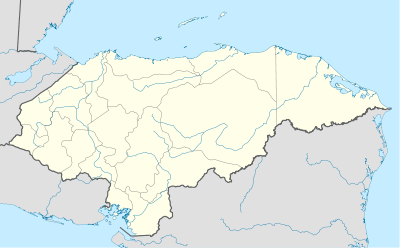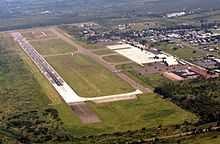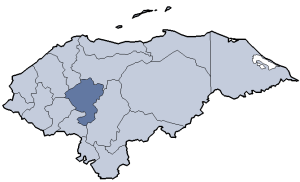Comayagua
| Comayagua | |
|---|---|
| City | |
 Comayagua | |
| Coordinates: 14°27′36″N 87°39′0″W / 14.46000°N 87.65000°WCoordinates: 14°27′36″N 87°39′0″W / 14.46000°N 87.65000°W | |
| Country |
|
| Department | Comayagua |
| Foundation | 8 December 1537 |
| Nearby Large Cities |
List
|
| Government | |
| • Alcalde | Carlos Miranda |
| Elevation | 594 m (1,949 ft) |
| Population (2005) | |
| • Total | 60,078 |
| Time zone | CST (UTC-6) |
| Website | comayagua.hn |
Comayagua (Spanish pronunciation: [komaˈʝaɣwa]) is a city in Honduras, some 50 miles (80 km) northwest of Tegucigalpa on the highway to San Pedro Sula at an elevation of 1,949 feet (594 m) above sea level.
In 2003 the estimated population was 60,000 people. It is the capital of the Comayagua department of Honduras. The city is noted for its wealth of Spanish Colonial architecture. The central square has a cathedral with the oldest clock in the Americas.
History
Comayagua was founded with the name Santa María de la Nueva Valladolid by Conquistador Alonso de Cáceres under orders from Francisco de Montejo, Governor of Yucatán on December 8, 1537. From 1540 on Comayagua was the capital of the Honduras Province of the Captaincy General of Guatemala. The Cathedral of the Immaculate Conception, on the main square, was begun in 1563 and inaugurated in 1711.[1]In 1786 (23 December) the Spanish Crown created the Intendencia of Comayagua, with Comayagua as its capital, which lasted until 1812. From 1812 to 1814 it was the capital of the Province of Comayagua when it again reverted to being the capital of the Intendencia of Comayagua until 1820. In 1820, Honduras was again called the Province of Comayagua or Honduras, with Comayagua as its capital. After independence from the Spanish it was the capital of the state of Honduras in the Federal Republic of Central America. After Honduras became an independent republic, the capital alternated between Comayagua and Tegucigalpa (Comayagua being preferred by Conservative administrations, and Tegucigalpa by Liberal ones) before being permanently established at Tegucigalpa in 1880.
In February 2012 a fire killed more than 350 people at Comayagua prison.

Places of note
Right in front of the plaza is located City Hall, which has been reconstructed a couple of times. The building is of neoclassic style and was built during the 16th century. The Cathedral of Comayagua was built during the colonial era in Honduras. It was inaugurated on Dec. 8, 1711.
Soto Cano Air Base

Soto Cano Air Base (formerly Palmerola Air Base) is a Honduran military installation located less than 10 miles (16 km) from Comayagua. The two miles (3 km) wide and six miles (10 km) long airbase is home of the Honduran Air Force Academy. United States maintains Joint Task Force Bravo on Soto Cano Air Base with approximately 550 U.S. military personnel and more than 650 U.S. and Honduran civilians.
Sport
Comayagua is headquarters of Club Hispano, of the Honduran National Soccer League. The club obtained its first promotion to the National League in 2004-2005. Nevertheless, after only their first season in the soccer league; they were relegated to second division once again. For this reason the board of directors, bought the first division franchise from Club Municipal-Valencia of Choluteca. The Club plays its home games at the municipal stadium 'Carlos Miranda' which currently holds about 10,000 spectators.
Comayagua was host to the first International Fellowship of Christian Athletes Motocross camp in September 2012. 60 men and women participated in the camp which was instructed by professional riders from the United States, Jimmy Povolny, Shawn Clark and Ryan Meyung among others. The camp was followed by a race sponsored by Colmotos Enduro and was in memory of Dylan First, a US rider who lost his life on the track the previous year. This is now an annual event in Comayagua with instructors from the US and leaders from Honduras.
References
| |||||||||||||
